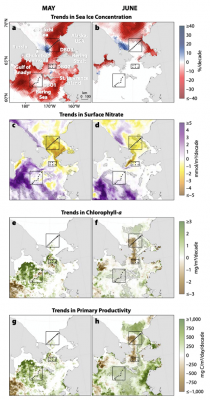Observations of Declining Primary Production in the Western Bering Strait
To investigate the recent biological change in the Bering Strait, we compiled a satellite-based time series of chlorophyll-a concentrations derived from Aqua-Moderate Resolution Imaging Spectroradiometer (Aqua-MODIS), which was combined with sea surface temperature data and additional data sets to derive net primary productivity using a broadly utilized algorithm that has previously been employed to report changes across the Arctic region. Modeled chlorophyll-a, primary production, and surface nitrate concentrations were obtained from the Regional Arctic System Model to provide insight into the mechanisms causing changes seen in the observations.
The early season declines in primary productivity in the western Bering Strait found in this study should undoubtedly have important consequences for the further downstream delivery of carbon and otherwise excess nutrients to the Herald Canyon and western/central Chukchi Shelf regions, important hotspots for biological productivity in the Arctic. Changes in the seasonal and spatial distribution of spring phytoplankton blooms in the Pacific Arctic will also likely have important effects on pelagic-benthic coupling in a region with historically high benthic biomass and large populations of seabirds and marine mammals that depend upon benthic prey for survival.
Despite measurements of overall, large-scale increases in primary productivity across the Arctic Ocean over recent decades, heterogeneity in shifts of nutrient availability to upper ocean waters across the region has also led to a spatial mosaic of both increases and decreases in productivity. For example, while earlier sea ice retreat can result in stronger blooms in Arctic shelf regions, increased sea ice melt can also result in reduced production in portions of the central Arctic owing to enhanced stratification. Significant declining trends in June surface nitrate concentrations from model results geographically mirrored the observed declines in chlorophyll-a and primary productivity. We hypothesize that because of the May declines of sea ice in the Gulf of Anadyr and resulting increases in May chlorophyll-a/primary production in that region, available nutrients downstream in the western Bering Strait during June are depleted, and chlorophyll-a/ primary productivity, therefore, have declined over time there as well.

